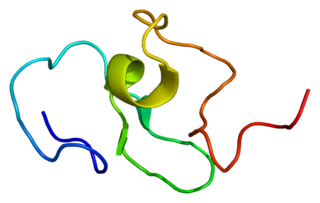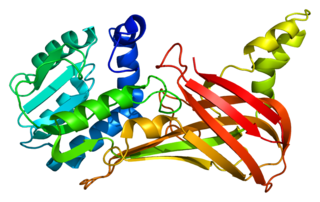
Bromodomain-containing protein 2 is a protein that in humans is encoded by the BRD2 gene. BRD2 is part of the Bromodomain and Extra-Terminal motif (BET) protein family that also contains BRD3, BRD4, and BRDT in mammals

Tyrosine-protein kinase, or Bromodomain adjacent to zinc finger domain, 1B (BAZ1B) is an enzyme that in humans is encoded by the BAZ1B gene.

Bromodomain-containing protein 7 is a protein that in humans is encoded by the BRD7 gene.

Dual specificity protein phosphatase 3 is an enzyme that in humans is encoded by the DUSP3 gene.

Protein kinase C-binding protein 1 is an enzyme that in humans is encoded by the ZMYND8 gene.

AT-rich interactive domain-containing protein 2 (ARID2) is a protein that in humans is encoded by the ARID2 gene.

Kaptin is a protein that in humans is encoded by the KPTN gene.

Shugoshin-like 2 , also known as SGOL2, is a protein which in humans is encoded by the SGOL2 gene.

Bromodomain-containing protein 3 (BRD3) also known as RING3-like protein (RING3L) is a protein that in humans is encoded by the BRD3 gene. This gene was identified based on its homology to the gene encoding the RING3 (BRD2) protein, a serine/threonine kinase. The gene maps to 9q34, a region which contains several major histocompatibility complex (MHC) genes.

Interferon-induced transmembrane protein 3 (IFITM3) is a protein that in humans is encoded by the IFITM3 gene. It plays a critical role in the immune system's defense against Swine Flu, where heightened levels of IFITM3 keep viral levels low, and the removal of IFITM3 allows the virus to multiply unchecked. This observation has been further advanced by a recent study from Paul Kellam's lab that shows that a single nucleotide polymorphism in the human IFITM3 gene purported to increase influenza susceptibility is overrepresented in people hospitalised with pandemic H1N1. The prevalence of this mutation is thought to be approximately 1/400 in European populations.

Protein Jumonji is a protein that in humans is encoded by the JARID2 gene. JARID2 is a member of the alpha-ketoglutarate-dependent hydroxylase superfamily.

TBC1 domain family member 10A is a protein that in humans is encoded by the TBC1D10A gene.

Putative Polycomb group protein ASXL1 is a protein that in humans is encoded by the ASXL1 gene.

Sodium/hydrogen exchanger 8 is a protein that in humans is encoded by the SLC9A8 gene.

N-terminal EF-hand calcium-binding protein 2 is a protein that in humans is encoded by the NECAB2 gene.

Ninein-like protein is a protein that in humans is encoded by the NINL gene. It is part of the centrosome.

DCC-interacting protein 13-beta is a protein that in humans is encoded by the APPL2 gene.

Protein arginine N-methyltransferase 3 is an enzyme that in humans is encoded by the PRMT3 gene.

Phosphoribosyl pyrophosphate synthetase-associated protein 2 is a protein that in humans is encoded by the PRPSAP2 gene.

JQ1 is a thienotriazolodiazepine and a potent inhibitor of the BET family of bromodomain proteins which include BRD2, BRD3, BRD4, and the testis-specific protein BRDT in mammals. BET inhibitors structurally similar to JQ1 are being tested in clinical trials for a variety of cancers including NUT midline carcinoma. It was developed by the James Bradner laboratory at Brigham and Women's Hospital and named after chemist Jun Qi. The chemical structure was inspired by patent of similar BET inhibitors by Mitsubishi Tanabe Pharma [WO/2009/084693]. Structurally it is related to benzodiazepines. While widely used in laboratory applications, JQ1 is not itself being used in human clinical trials because it has a short half life.


















